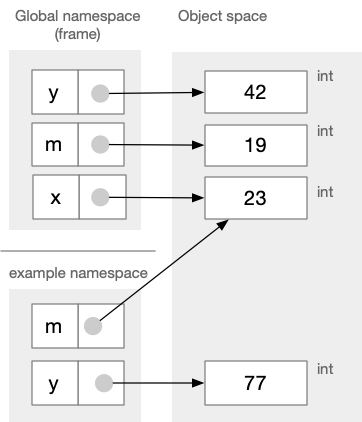Binding: Functions and Scope#
In the prior chapter and accompanying project we both used functions
that come built-in to Python (like max and sorted) and functions
that you can create yourself. In this chapter we will look further
at both, but especially at functions that you write.

Fig. 4 Tools alone will not make you a good cook, or a good programmer, but good cooks and programmers know their tools.#
Built-in and imported functions#
A collection of reusable software written by others and ready for us to incorporate in our own programs is called a library. Python has a rich set of libraries. In this course we will focus on libraries that come pre-packaged with a standard Python 3 installation. We will omit consideration of additional libraries that you can install, although you might use those in other courses or for side projects.
Always available#
Some functions are always present and available.
They are documented at
https://docs.python.org/3/library/functions.html.
The always available functions
include some we have already seen, like len and sorted.
They also include some more esoteric functions that you may never
use. You do not need to memorize them all!
Recall that methods are very much like functions, but instead of a
function call like len(s), we make a method call like s.strip().
The methods of the built-in types are not listed in the table above,
but they are documented with the types of data they operate on.
For example, strip is described in
documentation for type str.
Again, it is not necessary (or perhaps even possible) to memorize
all the built-in methods for all the built-in types. Bookmark the
Python standard library documentation page and refer to it
whenever you need to use them. You will soon enough remember the
functions and methods you use most often.
Importing other modules#
In addition to the functions that are always available and the types that are always available with their methods, the Python standard library includes a large number of optional modules. These are installed on your computer when you install Python 3, but they are not automatically available in your program until you indicate your intent to use them.
To gain access to functions and types from a part of the standard library that is not already available, you import it, like this:
import random
random is a module that contains several functions we might want
to use. For example, to generate a random integer between
25 and 100, inclusive, we could write
r_int = random.randint(25, 100)
print(r_int)
31
Notice that we cannot call randint without specifying that it
belongs to module random. That is because the module is a
namespace with a distinct set of names for functions and variables.
It is possible for the same name to appear in more than one
namespace, referring to distinct values or objects.
That’s the point of namespaces: Because each
module or other
namespace has its own set of names, we don’t have to worry about
accidental conflicts between names in different namespaces.
The global namespace (or scope) of your program is distinct from
the namespace of modules you import. When you import random, the
name “random” refers to the whole module, and is distinct from any
names
that occur within that module, like random.randint. It is even
possible for the module random to contain within it a function
that is also called random. It does:
r_float = random.random() # Returns v such that 0.0 <= v < 1.0
print(r_float)
0.29083962463969515
There is no confusion in interpreting the name random.random. The
part before the . is in the namespace of your program, so it
refers to the module. The part after the . is in the namespace of
the module, so it refers to function random found in module
random.
Note
This section introduces many closely related terms like scope, namespace, and frame, as well as some terms like argument that are often used interchangeably with other terms like parameter in Python documentation. It can be confusing! We have provided a short discussion of terminology to help you keep them straight.
Finding useful modules#
It is not practical to memorize the names of all the modules in the Python standard library, let alone all the functions in all those modules. Just bookmark the standard library documentation and search. The modules are mostly well-named and have clear, concise descriptions that will help you find what you need. Once again, the modules you use often will stick in memory without conscious attempts at memorization.
Defining and calling a function#
Recall that a Python function can be created by writing a function
header (starting with def) to define how it is called, and a
function body that describes how it works. Here is a simple
function that returns the absolute difference between two integer
values:
def abs_diff(x: int, y: int) -> int:
"""Absolute value of the difference between x and y."""
if x > y:
return x - y
else:
return y - x
The name of the new function will be abs_diff. Following
Python naming conventions, it
is made of lower case letters (no capital letters), with parts
separated by underscore (”_”). The following
chapter on pragmatics
discusses the choice of name in more depth.
Function abs_diff has two arguments, also called formal
parameters, x and y. The actual arguments passed to
abs_diff must be int objects representing integers. The
function header also indicates that abs_diff will return a single
int value. This information comprises the signature of
function abs_diff, which is (int, int) -> int. This is enough
to tell us that x = abs_diff(5, 7) is a legal assignment that
assigns an int value to x, but abs_diff("cats", "dogs") is
an error, as is abs_diff(3, 2) + "turtles".
Less obviously, abs_diff(3.2, 5.4) is a programming error, even
though it will return 2.2. This is because the header of a function
is a sort of contract between the author of the function and anyone
who calls that function (even if they are the same person). Passing
a floating point number like 3.2 to abs_diff breaks that contract.
As the next chapter discusses in more depth,
it is essential that a programmer who wants to make use of
abs_diff be able to depend entirely on the contract given by
the function header and docstring, without referring to the body of
the function.
Scope#
We saw earlier that when we call a function, the values we “pass” to the function are assigned to the formal arguments, which might have different names than the variables that we pass:
def diff(a: int, b: int) -> int:
"""Returns a - b."""
return a - b
x = 17
y = 14
z = diff(x, y)
print(z)
print(a) # Error! Variable a doesn't exist here.
3
---------------------------------------------------------------------------
NameError Traceback (most recent call last)
Cell In[4], line 9
7 z = diff(x, y)
8 print(z)
----> 9 print(a) # Error! Variable a doesn't exist here.
NameError: name 'a' is not defined
It may help to see this example step-by-step in PythonTutor. If you are viewing this chapter in a web browser, use the “next” button in the frame below to step through it.
In the example above, function diff, the value of x is assigned
to the formal argument a and the value of y is assigned to the
formal argument b, so we get 17 - 14 which is 3. Also, the
variables a and b exist only while diff is executing, so the
final statement will cause an error (“NameError”, which
basically means there is no variable a at that point in the program.)
If you assign to a variable within a function, that variable will likewise exist only as long as the function is executing.
def example(a: int) -> int:
"""Example return a + 1."""
thing = a
return thing + 1
x = example(41)
print(x)
print(thing) # No thing here!
42
---------------------------------------------------------------------------
NameError Traceback (most recent call last)
Cell In[5], line 8
6 x = example(41)
7 print(x)
----> 8 print(thing) # No thing here!
NameError: name 'thing' is not defined
You can also step through this example in PythonTutor.
We say that both a and thing exist in the local scope of
function example. It is even possible for two or more variables
with the same name to exist in different scopes.
# Global scope (global frame or namespace)
x = 23
y = 42
m = 19
def example(m: int):
"""Example to illustrate scope"""
y = 77
print(f"x is bound to {x} within example")
print(f"y is bound to {y} within example")
print(f"m is bound to {m} within example")
# Executing "example" creates the new local scope
example(x)
# When "example" finishes, the new scope is deleted
print(f"After example, x is bound to {x}")
print(f"After example, y is bound to {y}")
print(f"After example, m is bound to {m}")
x is bound to 23 within example
y is bound to 77 within example
m is bound to 23 within example
After example, x is bound to 23
After example, y is bound to 42
After example, m is bound to 19
You can step through this example in PythonTutor
During execution of example(x), the scopes created by the example
above look like this:

There are several things to notice:
Although there are two name spaces (scopes or frames) in the example, there is only one object space. PythonTutor shows the
intvalues directly in frames as a simplification, but they are actually objects in object space.When we call
example(x), the value bound toxin the global scope is bound tomin the scope ofexample(x). We say that the “actual argument”xis bound to the “formal argument”minexample(m: int). This is always how values are passed to functions in Python.The same value, an
intobject containing the integer 23, is bound to more than one name. This is called aliasing.
It will become important when we consider objects like lists that can be modified, with intentional effects or unintentional side effects.
Aliasing of the same int object to the name m in the
execution of example, and to x in the global namespace, is
hardly noticeable. We might compute some new value by adding the
values of 23 and 42, but that would be an entirely new int object.
We would not be changing the int object 23 mean something else
(thank goodness). We call int objects immutable because they
can never change value.
You can watch the example in action with
Python Tutor.
It should look very similar to our illustration above, except Python
Tutor will not draw the int objects in the object space. They
really are objects, but Python Tutor draws the integer values
without the objects that hold them to reduce clutter.
Global variables#
Generally we want to keep the local variables in one function execution completely separate not only from the local variables of other functions, but also from the global namespace of our program. We do not want to write code like this:
def bad_bad_bad(x: int):
"""Don't do this!"""
s.append(x) # s is not local to bad_bad_bad.
s = [1, 2]
bad_bad_bad(3) # Not obvious that we are changing s!
print(s)
[1, 2, 3]
In this example, bad_bad_bad is a function that accesses and
even changes the variable called s, not in its own namespace (the
local scope of the function) but in the global scope of the program.
The function is at least appropriately named. This is almost always
a bad idea. Python nonetheless permits it because there are a few,
rare cases in which accessing a global variable is needed.
If you are reading the online version of this text, you can
step through bad_bad_bad in PythonTutor.
One case in which we might need to access a global variable from
within a function is when the global variable is some kind of fixed
constant or configuration. For example, an anagram finder might
depend on a file that holds a list of dictionary words. We do not
want to bury the name of that file inside some function. We might
instead define it near the beginning of the program as a global
constant, like the variable DICT in the Jumbler project:
DICT = "shortdict.txt" # Short version for testing & debugging
# DICT = "dict.txt" # Full dictionary word list
# ... other code ...
def find(anagram: str):
"""Print words in DICT that match anagram.
... test cases here ...
"""
dict_file = open(DICT, "r")
# Reference to DICT is better than burying
# the configuration setting here in the function.
for line in dict_file:
word = line.strip()
if word == anagram:
print(word)
Note the Python convention of using all upper case letters to make it
clear to readers of this code that DICT is a global variable.
Very rarely we might need to update a global variable from within a function. This is quite unusual, and never something to be done without first considering alternatives. One of those rare cases is when for some reason we need to keep a count of how many times a function has been called. We cannot keep the count in a variable that is local to the function, because then the local variable would disappear after each call. A new variable would be created each time the function is called. This code will not even work:
count_foo = 0
def foo() -> int:
"""This will not work!"""
count_foo = count_foo + 1
return count_foo
print(foo())
print(foo())
print(foo())
---------------------------------------------------------------------------
UnboundLocalError Traceback (most recent call last)
Cell In[8], line 8
5 count_foo = count_foo + 1
6 return count_foo
----> 8 print(foo())
9 print(foo())
10 print(foo())
Cell In[8], line 5, in foo()
3 def foo() -> int:
4 """This will not work!"""
----> 5 count_foo = count_foo + 1
6 return count_foo
UnboundLocalError: cannot access local variable 'count_foo' where it is not associated with a value
What happened here? While we may have intended to access the global
variable count_foo from within foo, we did not. Because there is
an assignment to count_foo, Python has created a local variable
count_foo. It has the same name, but it is not the same variable,
because it is in the namespace (scope) of the execution of function
foo. When Python attempts to evaluate count_foo + 1, it
references the local variable count_foo and finds that it does not
yet have a value. Hence the “UnboundLocalError”.
If we really, really wanted to reference and change a global
variable, Python will allow us to explicitly declare that it is
the global variable count_foo we want to refer to, and not a new
local variable with the same name.
count_foo = 0
def foo() -> int:
"""This will work. That doesn't make it a good idea."""
global count_foo
count_foo = count_foo + 1
return count_foo
print(foo())
print(foo())
print(foo())
1
2
3
If you are reading online, you can trace it in PythonTutor.
Hygiene and pragmatics#
Even in this section devoted to the basic mechanics of defining and
calling functions, it has been difficult to completely avoid talking
about good and bad approaches. The
next section
takes up hygiene of function design in more depth.
Instructions for our project
discusses pragmatics of choosing parts of the code to decompose into
functions.
Terminology#
The many terms like scope and frame can be confusing, especially since you will encounter different names for the same or closely related concepts in documentation. We have provided a brief terminology review to help you sort them out.

